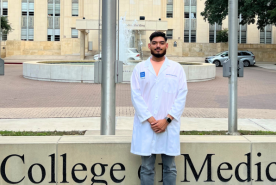In recent years, better ultrasound machines have allowed your doctor to see your baby's kidneys more clearly during pregnancy. Different types of problems can be found including absence of one or both kidneys, abnormal position of a kidney, hydronephrosis (swelling of a kidney), fluid-filled cysts and tumors.
The following overview of the urinary tract will help you understand the problems your baby may have.
What does the urinary tract do?
The main function of the urinary tract is to remove wastes and fluid from the body. The urinary tract has four parts: the kidneys, the ureters, the bladder and the urethra. The urine is formed when the kidneys filter blood and remove excess waste materials and fluid. The urine collects into a part of the kidney called the renal pelvis. From the renal pelvis, the urine travels down a narrow tube called the ureter into the bladder. The bladder slowly fills up with urine, which empties from the body through another small tube called the urethra.
During pregnancy, the baby floats in the amniotic fluid within the mother's womb. This fluid is composed mostly of urine made by the baby. If not enough urine is being produced, there may not be enough amniotic fluid.
What types of problems can happen to the urinary tract in the baby?
Birth defects can occur in any part of the urinary tract. For example:
- The kidneys may be missing or in a wrong position.
- A blockage of the outflow of urine or reverse flow of urine already in the bladder (called reflux) can cause the renal pelvis to become enlarged. This is usually called hydronephrosis.
- A blockage of the urethra can affect emptying of the bladder, causing the pressure in the bladder to be greater. This places extra pressure on the renal pelvis in both kidneys and on the ureters, which can dilate. In boys, the most common blockage of the uretha is called urethral valves.
- Two ureters can drain a single kidney. In some cases the connections can be abnormal and hydronephrosis or reflux can be a problem.
What types of problems can my doctor see on the ultrasound?
Hydronephrosis is the most common abnormality detected on the ultrasound. It occurs when part of the urinary tract is filled with too much urine, which is often, but not always from a blockage. Other problems that may be found include absence or wrong position of one or both kidneys, cysts (fluid collections within the kidney tissue) or tumors (solid lumps) in the kidneys.
What type of special doctors can help?
Pediatric urologists are surgeons specially trained in the care of children's urinary and genital tracts. Pediatric nephrologists also care for kidney and urinary tract problems in children, but do not do surgery. Both pediatric urologists and nephrologists are familiar with the diseases of the urinary tract and know how to manage these problems after birth. In addition, these specialists may be able to provide helpful information to your obstetrician.
What should I expect during the pregnancy?
If your baby has hydronephrosis, your obstetrician will monitor your pregnancy more closely. More frequent ultrasound testing may be performed. Sometimes, the amount of amniotic fluid can be lower than normal. This could be due to a leakage or to decreased production of urine by the baby. Decreased urine production may be a sign of a significant kidney problem. In rare cases, samples of the baby's urine might be required. Most often, no specific treatment is required during the pregnancy, but evaluation by a pediatric urologist or nephrologist is needed after birth to identify the problem more specifically and to decide whether treatment is needed. Very rarely, a tube may be placed into the baby's bladder during the pregnancy to bypass a blockage. Another alternative is to deliver the baby early, but in most cases, no treatment is needed during pregnancy.
What types of tests are performed on the baby after birth?
The discovery that your baby has hydronephrosis allows for the prevention of complications that your baby might otherwise have, such as urinary infection or stones. Your pediatrician should be notified about the abnormality before the birth of your baby, so the appropriate tests may be done after birth. Usually, a kidney and bladder ultrasound will be performed during the first week after birth. In addition, your baby might be started on low-dose antibiotics to prevent urinary infections while more testing is being done. Further tests that may be done include:
- a bladder x-ray (VCUG, which stands for voiding cystourethrogram)
- a renal scan for function and drainage of the kidneys
Based on the results of these tests, a specialist can help determine if the problem is severe enough to require an operation or whether the problem is likely to go away on its own. Often further ultrasound tests will be done to see if the problem is getting better.

















